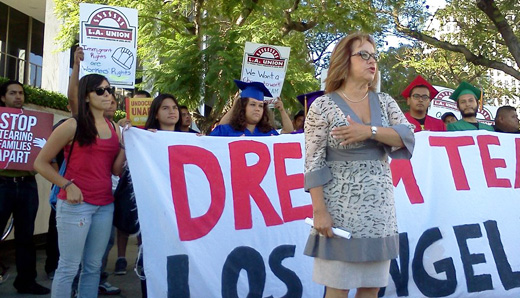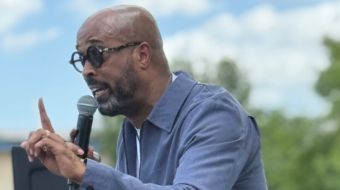
Some political commentators and social scientists tend to credit the increasing political influence of Latinos to their rapid growth in the general population, particularly the voting population.
But important as demographic growth of the Latino vote is, it’s more significant that by a large majority, Latinos have emerged as a progressive nationwide political bloc, not limited to the Southwest and certain Eastern and Midwestern population pockets.
It’s a political bloc that no amount of right-wing posturing will let the Republicans capture in any significant numbers. And it’s sending a strong signal to conservative Democrats to shape up or ship out.
Some say a precursor of what’s to come on nationally can be seen in the nation’s most populous state, California. And they may well be right.
Latinos made up 30 percent of California’s population in 1990 but will reach 40 percent by the end of this year, and are expected to reach 48 percent by 2050.
In the fateful year, 1994, former Republican Governor Pete Wilson shepherded a law through the California legislature to ban undocumented immigrants from prenatal care and from public schools.
Then, public opinion in the state favored more stringent measures against undocumented immigrants.
But little did Wilson and his Republican right-wing cohorts suspect that their viciously anti-immigrant law would bring on “the perfect storm to anger and motivate a big number of Latinos,” María Elena Durazo, head of the Los Angeles County Federation of Labor, recently told the New York Times.
Immigrant and native-born Latinos alike, and their progressive militant leaders, responded with massive marches to what was rightly perceived as a racist, jingoistic assault on the whole Latino community, particularly on working-class families.
“Once we had them coming out,” Durazo added, “we made sure they kept voting.”
Massive drives began to naturalize documented immigrants and register to them to vote, and to help undocumented people with grounds to claim legal permanent residency.
In the most recent election, exit polls showed that Latinos made up 25 percent of the vote in California, compared with 9 percent in 1994, according to Mark Baldassare of the Public Policy Institute of California (PPIC).
In just the last decade, cities that were largely white have become majority Latino, including those in districts formerly thought safe for Republicans.
Dozens of city councils have a Latino majority. A Mexican American is mayor of Los Angeles and another leads the State Assembly.
In the 120-seat state legislature, the Latino caucus now has 24 members, more than double two decades ago though still not reflecting the percentage of Latinos in the general population.
Meanwhile, since the 1994 law was approved, and later ruled unconstitutional by the federal courts, the ideological reality has changed dramatically.
Now, more California residents than ever before say that immigrants benefit the state, according to PPIC polls.
In California, Latinos – together with large majorities among African Americans, Asian American Pacific Islanders, Native Americans, women and youth – played a huge part in delivering a devastating blow to the Republican Party and its rightwing agenda in November.
Besides delivering an overwhelming vote for President Barack Obama, Latinos helped elect an all-Democratic ticket to statewide offices, win a veto-proof Democratic supermajority in both legislative chambers, and add four more members to the Democratic congressional delegation.
“Nobody had ever gone out to new citizens in the immigrant community, to poor working-class immigrants, but they turned out to be very reliable voters for us,” Durazo said. “Now the rest of the country is starting to catch up.”
“For a long time, we were living in no more than four or five states,” Durazo added, “but now, we are in the smallest towns of Georgia and Alabama. And once we’re there, it gets harder to ignore or hope that immigrants will just go away.”
As Congress begins debating an overhaul of the immigration system, many in California sense that the country is just starting to go through the same evolution the state experienced over the last two decades.
Progressive trends among Latino immigrants in other parts of society are bound to reveal that Republicans’ cosmetic changes on immigration and other issues will fall flat among most Latinos.
While Bureau of Labor Statistics (BLS) figures show the relentless right-wing attacks on labor nationwide caused overall union density to drop to 11.3 percent last year, in California union membership grew by more than 110,000 members, increasing overall density to 17.2 percent.
Latinos in the state were part of both these trends.
“The Latino population is growing in California,” said California Labor Federation head Art Pulaski. “Latinos and other immigrants are more prone to join unions. A lot of Latinos developed a historic sense of economic and social justice in their home countries.”
Other southwestern states, such as Nevada and Texas, are also seeing growth in union membership. Latino workers are playing a big role in this growth.
“This has a lot to do with the changing demographics of the workforce in these states,” Ruben Garcia, a labor law professor at the University of Nevada in Las Vegas, told the Los Angeles Times.
“The big campaigns in the car-wash industry in LA, the janitors in Houston and the people who work on the Strip here tend to be an immigrant Latino workforce that’s willing to stand up at the workplace, sometimes with great risks.”
Photo: Los Angeles Federation Executive Secretary-Treasurer Maria Elena Durazo speaks to Dreams, carwasheros, and community allies gathered to celebrate the start of the Deferred Action process for Dreamers. (AFL-CIO Latino)










